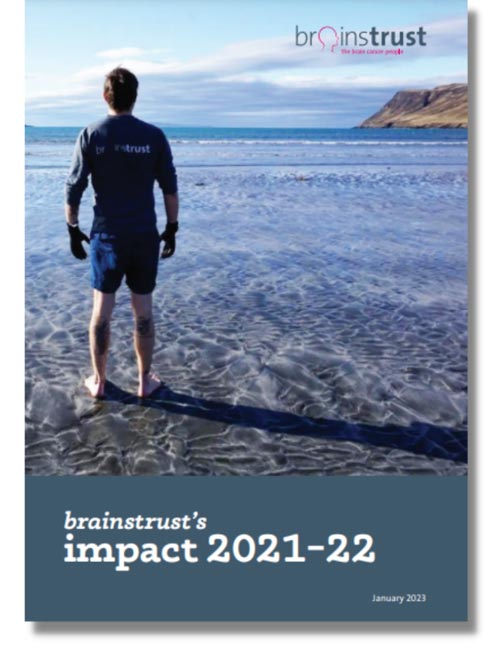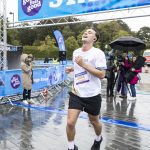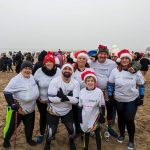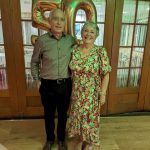Lynn’s Story
I was born in January 1966, am married to Paul and have a wonderful daughter Katie who is 16 in Sept. I worked as a radio operator in a control room, working 4 days on and 4 days off, had a good social life and we had 2 nice cars, lovely house, good holidays (the last one being Jamaica, Aug 2007). We also have one nutty collie and a blind rabbit!
October/November 2007
I’d had neck pain for several years on and off and it was put down to a car crash I had some years ago. Painkillers and a course of physio seemed to sort it for short term. But, whilst on holiday in Jamaica I had odd problems with walking and general breathlessness. We put this down to heat and the fact that my legs and feet swelled. My balance was off and in October 2007 problems with my vision began, especially when first getting out of bed. Vision was restricted in one eye and then it appeared to drain and I could see again. I went to the opticians and after several examinations they called my husband and said my eye appeared to be haemorrhaging. I needed to go to hospital for more tests. We were worried, but thought it something and nothing. The next few hours were taken up with CT scans, MRI and blood tests. Can I wiggle my fingers and toes? Stand on one leg? Then came the blow: they had found a mass, and I would be transferred to a London Hospital who were more informed on these things and explain more…
That was 6/7 November. A few days later I was taken by blues and twos to London, where I was diagnosed with a right hypoglossal nerve sheath tumour. To add insult to injury I also had water on the brain, so the next day an urgent VP shunt was done.
December 2007
On 1st December I was readmitted for an operation on part of the tumour. It was a dumbbell shaped part on the brain stem area and in another part in skull. It was explained that my voice could be affected and there could be several other side effects, but you have to put your life in their hands. The surgery went really well, but we later found my voice was hoarse and I had double vision, also swallowing had become problem, so I was on a feeding tube. After 3 weeks of seeing speech therapists I was able to eat soft food and drink thick fluids which had a consistency of wall paper paste! I had a prism on my glasses to help with the double vision and I was home in time for Xmas and a dinner of mash, gravy and few soft veg, but still very much alive.
February 2008
All was well until February. I became very sick, had bad headaches and lost over 3 stone. Another scan revealed a cyst growing off the tumour again. I had become bedbound prior to surgery due to lack of energy as I was not able to keep food down.
June 2008
I was operated on again and bounced back to health. I was home in 7 days, able to return to almost normal life, my voice still hoarse and only able to swallow thickened fluids still. I could not walk too far but thought that might come with time.
I managed to go back to a desk job; my employers are very supportive and colleagues with whom I’m working now really encouraged me to get on.
October/November
Unfortunately I was not feeling too well again. Another scan showed yet another growth which was bigger this time, so more surgery was planned for the new year when surgeon could fit it in.
January 2009
Surgery was booked for 26th January. The operation removed the cyst but I had a bleed leaving me weak down my whole right hand side. I could just about move my right arm, but could not feel it. My leg had just slight touch sensation but nothing else. I could control my bodily functions. This felt like an operation too far; I was extremely depressed, my family lived miles away and I was in a room on my own. I could not feed myself or make drinks (even thick ones) and they wondered why I felt suicidal, even asked me had I thought how I was going to end it all? If I could have got out of bed it might have been a start!
Three weeks in London and my family and friends turned up in worst snow we had in years to see me, but nothing boosted my moral more than being transferred to my local NHS hospital in Bedford and a fantastic bunch of nursing staff. I was also only 5/10mins from home so my husband, daughter, and sister could just pop in and out. One of the best things was a friend who came in and washed my hair, bowl on the bed! But after 4 weeks it was just what a girl needed. They also gave me a shower, better than any bed bath, our NHS nursing at its finest, thank you!
March 2009
I was transferred from there to rehab in Harrow, where they started the long process of teaching me to walk. Although slowly, I can at least now get round the house and climb stairs. They retrained me on the toilet, which at 43yrs is something no one should have to go through but they are patient and reassuring. They also sent me to see an ENT surgeon who sorted my voice by putting some sort of plastic into my vocal chord, which means no more thickened drinks and I can call the dog/child and they can hear me!!
Whilst at RRU Harrow, I met people in similar circumstances as me. One was Alex Jones whom brainstrust also supported. He beat me several times at Connect 4. It was reassuring to know there are other people going through the same fight; we all spurred each other on. (Sadly, after a long fight Alex passed away in January 2010 from complications)
There were days when things got tough, where I could have given up but seeing others round me fighting to get back on their feet, it gave me a boost.
May 2009
Since coming home in May I have had physio at home and am doing well, just waiting for my new consultant, oncologist and ENT surgeon to decide how to treat the remaining tumour, either radiotherapy or more surgery, I know what I would rather have.
I’m hoping all being well to go back to work in Sept and hope soon to have specially adapted car.
Each day is hard work and just getting washed and dressed a struggle, but, I’m alive and determined to see my daughter grow up into a beautiful young lady and be around to spend Paul’s pension.
July-August 2009
Have transferred to Addenbrookes, Cambs, because been having sickness and dizzy spells again, they have done another MRI and we have to wait for the result.
Sept 2009
I have taken delivery of a new Ford Fiesta in bright green and it has been adapted, it is automatic but I am able to drive it with my left foot, it has flip pedals so husband can use it as well. I am not used to driving automatic so husband took me out for test drive and come back with whiplash. Will have to remember it’s a break and not clutch!
Have also gone back to work part-time but just waiting for call from hospital as too outcome of scan.
We got the call and devastated to hear that the tumour is back again and more aggressive, but the consultant along with two others is confident they can remove it. They now need to get a team together and arrange theatre and Intensive care space.
Oct 2009
We get the call on the Friday morning to say operation will be on the Monday, not much time to sort anything out but hopefully will only be in couple of weeks.
The day of op and they have 3 consultants along with the theatre teams, I am petrified but don’t have much choice; it’s either let them try or die. I have written my funeral plans and letters to loved ones just in case, it all seems so unreal.
Operation goes ahead and 16 hours later they have managed to get 95% out, I spend some time in intensive care then back on ward. A few days later they try to get me up to walk and I managed a few steps but that was to be last time for several months.
It now turns out tumour was malignant and caused damage to top of my spine and base of skull, so I will require more surgery to pin it. Also I am unable to swallow so now require a feeding tube, really starting to think is it worth it?
Nov-Dec 2009
Still in hospital and have pneumonia, can’t walk because of all muscle wastage, on feeding tube and its coming up to Christmas. Really wondering what I have done to deserve this?
Christmas day the nurses did their best to keep spirits up, no xmas dinner for me – just soya feed through tube in stomach. Paul and Katie came in with pressies and video messages from friends and family, it was very emotional. Still, the upside was I was still alive and given another chance.
Jan 2010
Booze free new year !!
Jan 19th – the operation to pin my neck, they say this will limit my movement, but should stop my wobbly head and with any luck sort pins and needles in my good arm. The operation was a success but now have another scar down back of neck and bone graft on hip to deal with. It has resolved my pins and needles and for the first time in weeks I can start texting again.
Feb-March 2010
I have an infection in wound from last op and need to have another operation for wash out and another 2 weeks of antibiotics, also, still being sick, now lost 4 stone so good job I was overweight to start off with.
Time seems to move slowly, but have started physiotherapy to learn to walk again; it’s so painful due to being in bed for 4 months. Also, have to toilet train again and learn to take a shower, all the things we take for granted. Still need to have radiotherapy as well, so no date for going home yet.
April-May 2010
Six weeks radiotherapy starting middle of month and have had a mask made which is very unpleasant. It looks like something from Silence of the Lambs. The mask has to be worn at every treatment and you have to be screwed down to table to ensure you are in right place, thank goodness it only last about 10 mins each time.
It’s made me a bit sick, very tired and I have lost bit of hair round back of head, this had just started to grow back.
Have been home on weekend leave with my zimmer frame, they are trying to get me used to the outside world again.
June 2010
All treatment finished and will have to see if radiotherapy sorted last bit of tumour left, can take up to 6 months to see if it worked.
I have also been allowed home, after 7 and half months it’s a real shock not only to me but the family. Still on feeding tube but managing quavers and skips, pasta and omelettes, so hope in time it may improve. Walking bit better but using a frame. I have also been back for a small op on my throat to pump more plastic into my vocal chords, this enables me to swallow liquids again and for them not go down my windpipe.
I could not have done this without my husband, daughter and some good friends, along with the wonderful doctors and nursing staff on A4, Addenbrookes, they are like my second family now.
Update January 2012
I can’t believe I have been home 18 months and not going to lie – it has been hard on all of us. I slowly managed to eat soft foods and chocolate!! And by Dec 2010 was taking in enough calories to stop the soya feed and have the tube removed from my stomach, which was nice not to have to worry if it was hanging from under my t-shirt.
I spent most of 2011 regaining my strength and trying to have as normal home life as you can, following a fight like mine. I have had my fair share of falls because of my balance and vision problems (sometimes people must think I’m drunk!!). I know I have a very short temper. We are looking to buy a caravan so we can go on holiday and I will be in my own space and we hope this will save me getting confused/disorientated when in strange places. I had my first glass of low alcohol wine the other day for my birthday and it felt like I had drunk the whole bottle…so I’m now a cheap date.
The moral is to never give up the fight because there is a chance you will win!!!
With brainstrust, you are never alone. Click here to get in touch with one of our trained volunteers who has been through the same experiences you are going through.








